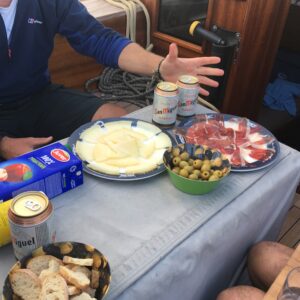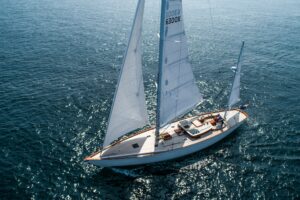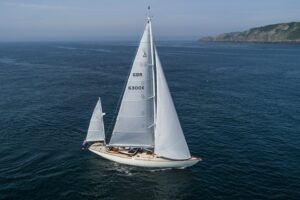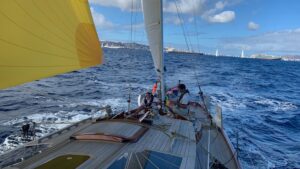
ATLANTIC OCEAN


Las Palmas to St Lucia:
Total distance: 3,166 nautical miles
Total time: 17 days
Crew: x5 (Peter, Simon, Jan, David and Tim)
In late November, as the rest of us started thinking about Christmas, Spirit DH63 Gwenhyfar and her crew of five Guernsey-men (Peter, Simon, Jan, David and Tim) were preparing to race in the 2019 Atlantic Rally for Cruisers (ARC).
Organised annually by the World Cruising Club (WCC), the ARC is on many sailors’ bucket lists as it offers the challenge of an ocean crossing with pre and post-race shoreside support and the reassurance of sailing within a fleet. Having begun in 1986, the rally now attracts over 200 boats and 1,200 people every year to sail approximately 2,700nm across the Atlantic from Gran Canaria to Saint Lucia. Once in Saint Lucia, a winter season of Caribbean cruising awaits.
Upon arrival in Las Palmas, the crew of five friends spent a week provisioning, making last minute trips to the chandlery, and carrying out safety precautions and rig checks.
At 12.15pm on Sunday 24th November, Gwenhyfar set off in the racing division in beautiful sunny conditions with the sound of cheering dockside well-wishers, brass bands and horns in the background. The Spanish Navy sounded the gun for the start and Gwenhyfar was on her way; racing at a pleasant 10 knots to the south with the vast Atlantic Ocean ahead of her.
Before delving into the details of the adventure, it is worth noting the routine onboard Gwenhyfar to gain an understanding of daily life at sea. The schedule and upcoming daily blog extracts tell you much about the crew: they are an organised bunch, they like a joke and rarely do anything without a smile and, as previously noted in Gwenhyfar’s Travels, food is high on their agenda.
Meals during the trip included mushroom risotto, prawn spaghetti, chicken and pancetta with potatoes and broccoli, fish pie, Teriyaki salmon, gazpacho soup, smashed avocado and smoked salmon on toast, and freshly baked cakes. Not bad from the galley of a 63ft sailing yacht.


The five crew had a watch system of four hours on and four hours off in staggered teams of two, with the fifth person as “Mother” for the day. The daily blog explained: “Mother duties include keeping Gwenhyfar clean and tidy below and preparing all meals. The upside is that “mother” gets a full night’s sleep without any watch duties for a full 24-hour period. For our crew of five this creates an efficient and happy little ship.”
Breakfast kicked off at around 8am followed by mid-morning ‘real’ cafetière coffee, accompanied by chocolate brownies or ‘millionaire cake’. A light lunch of sandwiches or pasta was served at 12.30hrs and mid-afternoon saw tea and cake served in the cockpit as the crew gathered to discuss progress and possible sail changes (and partake in the odd team crossword).
Before 17.00hrs, the night sail plan was implemented, which included changing or stowing the mizzen or staysail. As a yawl rig, Gwenhyfar has two keel stepped masts, which can hold up to four sails at the same time, which allows sail area to gradually be reduced as the wind strength increases. Within her OneSails wardrobe, Gwenhyfar has a light (red) spinnaker for winds up to 18 knots and a heavy spinnaker (green) for winds up to 30 knots, as well as a Code Zero, mainsail, furling jib, mizzen mainsail and an eye-catching yellow mizzen staysail.
The daily blog explained the benefits of the mizzen staysail: “The “funny sail” is popular because she often provides an extra half a knot of power. As a by-product she provides cockpit shade; and as a prerequisite for every Suffolk, Spirit-built yacht, she looks pretty.”
After the ‘night sails’ were rigged, happy hour began: “typically nuts and olives to accompany our sundowner. Most of us drink a tonic water or lemonade or occasionally a single beer. Again, this is a very social occasion and if the weather is fine, we would often sit on the foredeck.” All sounds very civilised.
The blog continued: “Dinner is served directly after ‘happy hour’ and is followed by a simple dessert. Then coffee, and the night watch prepare the boat; they walk around the deck, check rigging for chafe and remove any errant flying fish. Then they switch the navigation and compass lights on and generally steady the ship into a more conservative, but still fast sailing plan.”
Back to the racing…
After a breezy start on day one, (Tim clocked a new top speed of 15.8knots) and after sailing a total of 187miles, Gwenhyfar was 50miles off Western Sahara.


For the following three days the wind became light and fickle and the many of the yachts grouped together looking for even the slightest hint of breeze on the horizon. One afternoon was spent stationary for four frustrating hours…
Fashion was foregone as the crew donned their wide-brimmed hats to stave off the increasingly hot midday sun, UNO championships commenced, and the crew settled into life on a glassy, windless sea.
One benefit of the lack of wind meant conditions were safe to send Simon over the side one afternoon to dive down and free a fishing line caught around the prop during an overnight sail.
Whilst the sailing was somewhat frustrating, mother nature certainly delivered those ‘magic moments’ we all dream of when thinking about bluewater cruising. One evening as the sun went down, dolphins supplied the evening’s entertainment.
The daily blog described: “Two large pods of maybe 50 or more dolphins were racing and jumping very high and with the occasional flip of their tails they treated us to their acrobatic show! When it became dark, the show became an underwater phosphor spectacle. Interlaced barrelling traces of phosphor gave off electric green yellow and pink flashes of light. Their sparkling paths were lit like torpedo tracks as they disturbed and excited the prawns and squids. It was a dramatic display all around Gwenhyfar. In the night sky above, Saturn and Jupiter were setting in the west as all the constellations complemented the dolphins with their own starlight show.”
Early on in the crossing, Gwenhyfar’s Iridium Satellite communications developed a fault meaning the crew was unable to downloaded much-needed weather forecasts for the majority of the trip. In steps Guernsey-based ‘ground crew’ Colin (regular regatta foredeck crewman), who ended up sending over 30 emails with weather and routing information.
Using the data from Colin’s emails, tactics were discussed at length each day and various sail plans were tried and tested to maximise the limited wind. The decision was made to continue to head south and close to the Cape Verde Islands where they hoped to pick up the trade winds. From there, they would set a westerly course to St Lucia hoping to avoid the wind hole that was tracking south across the race rhumb line.
Night sail plans were set to avoid gybing in the dark with the crew preferring to make the last gybe at dusk and the first at dawn. The daily blog noted: “This plan was not only safer, but the full crew could be available to manage the gybe, which took 15 minutes to execute (not like racing at Cowes with 13 crew!). Ocean-racing Gwenhyfar, with guardrails, makes the gybing process much slower. The guardrails are a safety requirement for this race (normally we go classic racing without them where good looks are mandatory!). However, the guardrails mean we have to rig a cat’s cradle of cross tweakers and guy tweakers to keep sheets and guys off guardrails stanchions and brightwork to minimise chafe.”


After a week at sea, the wind had stabilised and life onboard the Gwenhyfar was well-established with approximately 2,000nm to go. Peter wrote in the daily blog: “By now, Gwenhyfar was hotted up (sailing a faster and higher angle, rather than nearly straight downwind) and sailing a course of 200′ with 105′ apparent wind creating a comfortable boat speed of 8 knots. Our preferred setting was red kite (light), full main and yellow mizzen staysail. Auto pilot set in leisure mode and to apparent wind angle worked well for this sail plan. We were now making consistent progress and moving away from the danger zone of fickle winds. Crew spent the afternoon lounging around on deck, doing crosswords, and watching dolphins dance around our bow. Maximum wind speed during the night was 21 knots true. Gwenhyfar was often topping out at 12 knots as she surfed the waves and was consistently making 8 knots to the SSW.”
With sailing speed looking more promising, attention was turned to the provisions: “Some food items were becoming critical, namely the sought-after brownies, which were now down to only four portions. Remaining items of fresh food – some salads and dodgy peppers were committed to the deep. After seven days at sea our remaining fresh vegetable produce are potatoes, courgettes and butternut squash. Fruit is lasting well but we are expectedly down to one day’s worth of bananas. Unfortunately fishing, which we had hoped would supplement our diet with fresh, high-quality protein, has been unproductive. In the early days the water was too cold at 18- 20′ and now the sea temperature is at 25′ we are in the zone of tropical fish like Dorade, but we are sailing too fast at 9-10 knots to safely haul in a catch. It would be rather tricky to slow our sleigh ride to land a fish!”
The coming days brought the welcome trade winds and some not-so-welcome flying fish. Whilst on watch one evening, Peter found himself up close and personal with one of the airborne visitors: “Peter was on watch, diligently looking out towards starboard and windward. It was pitch black out there. Then a shout of **** **** and we were a man down! Peter had received a 20 knot mighty wet smack in the face as a kamakazee flying fish came shooting over the low freeboard. Several other fellow flyers made a crash landing in the cockpit and further forward another determined group splattered into the deckhouse starboard windows. Peter went below to clean up his face, washing smelly scales out of his ears and nose before bravely resuming his watch. This time wisely concentrating to leeward and port!”
By day ten, Gwenhyfar was riding the trade winds at speed and with seas the size of “small bungalows” the crew were mostly hand-steering. Wind was 15-18knots but frequent squalls of driving rain and 30knots had begun to pass over them.
Shortly after tea one afternoon, “a particularly large semi-detached house size wave lifted Gwenhyfar’s stern and pushed her downhill a little off skew at the same time the jaw at the end of the spinnaker pole opened a fraction and released the heavy spinnaker guy to fly free and the lime green kite skied. The pole was now a javelin looking for a target! The inevitable happened and it skewered the clew of the lime green spinnaker and ripped a dustbin lid sized hole in it. We quickly took down the damaged sail, launched the headsail on a goose winged pole and settled our little ship.”
That evening, Gwenhyfar’s resident navigator and sail maker Jan and ARC-regular Simon (this was his 15th) worked to repair the damaged spinnaker.
In the morning, the crew reviewed the situation and a sail plan was implemented based on the winds being too strong to launch the newly-repaired kite: “The funny sail was promoted to foredeck duties. It was turned upside down and rigged to fly free on the port side of the starboard poled out headsail, whilst the main continued to be deployed with 1 reef on port side. This became about a knot faster and steadied us. We are now flying again at an average 10 knots in 24-28 knot winds and surfing down the waves. We are not sure how many other sailors will have sailed an upside-down mizzen staysail from the foredeck!”
By now, Peter was reporting “townhouse size waves that Gwenhyfar handles like a natural”. When commenting on the amount of water on deck, Peter noted: “Our stern is entirely dry. The bows receive a light gurgling and spray blows over but on the whole, we are dry after the first 10 feet or so. Just as important, the motion is sweet and mostly predictable. In the saloon she is comfortable and makes muffled whooshing sounds as the waters sweep down her flanks. She is such a comfortable and well-behaved vessel and so light to helm, even in these big chunky following seas.”


On day 12, a belated (due to the spinnaker ripping incident) “Over Half-Way Party” saw party snacks and tapas of Manchengo cheese, Iberian ham and anchovy olives in the cockpit table.
By now, Gwenhyfar was averaging approximately 190-200nm per day and the waves had stabilised back to ‘bungalow size’ allowing a successful test of the repaired heavy spinnaker. Speed under the repaired kite sat at 9-10 knots with the occasional downwind surf at 12-14 knots.
By day 15, with 770 miles to go, Gwenhyfar was well and truly ensconced in a game of cat and mouse with the increasingly frequent squalls. Peter wrote: “Gwenhyfar is now getting a regular bath time late evening and early morning as squalls catch us up and we enter a rain deluge. We try to dodge them, but it’s very tricky. So, the inevitable happens – all hands to shorten sail, then we get blasted by the wind, then soaked, before being spat out at the end of the storm into bright sunshine. Then full sail set is hoisted again. This has been repeated over six times in the last 24 hours.”
Wind speed peaked at 42knots during one particular squall, giving Simon the new record speed of 16.5 knots.
After a few days of heavy winds and frequent squalls, Gwenhyfar reached her penultimate day at sea. With just over 200 miles to go and Bob Marley and the Wailers on the sound system, they were on the home straight…
As dawn arrived on the final day, Gwenhyfar raced towards St Lucia at record speeds under heavy spinnaker and full main. Simon recorded a new record speed of 16.6 knots (gold medal position) and as they rounded the northern tip of St Lucia, Gwenhyfar surfed down the waves under full spinnaker at 14-16 knots: “the best sailing of the trip”.
Race control confirmed Gwenhyfar’s finish as: 8th in Racing A Division, 17th out of all race boats, and overall 50th finisher in a fleet of over 260 boats.
Peter reflected on their performance and the trip as a whole in his final blog:
“We were happy with that. Our race was good on day 1 then went very soft during days 2-5. Our Iridium was unreliable, and we fell into a series of wind holes. The middle sections were quite fast. In these light winds our red kite pushed us along at a very respectable speed. The last 1,400 miles were very windy with tricky seas, but we sailed fast, making several 200-mile days. Our last day was a record 223 miles! We sailed 3,166 miles and finished at 12.15hrs on 11th December.
“Rum punches – fruit bowls and the yellow shirts of the ARC team met us on the dockside. A series of telephone calls to family – then some more rum punches! A St Lucian style welcome.
“A sincere thank you to the Spirit Yachts yard in Suffolk who have built a truly beautiful vessel. Gwenhyfar is a perfect combination of function and form. Everywhere we go people comment on her sleek lines and good looks. She is very seaworthy, and all the deck gear worked well. These splendid craftsmen and women are building superb wooden yachts in Suffolk. Thank you OneSails for providing Gwenhyfar with a great wardrobe of sails.
“Finally the crew has been great. The right combination of banter, work, and a shared objective has built a united team. We have all enjoyed an epic and unforgettable experience. Until the next adventure…!”


WHAT THE CREW SAID:
David, engineer:
When asked about his favourite item onboard, he said: “It’s got to be the generator. It’s a Fisher Panda with an auto start facility, which means it loads up supplies as it warms up to operating speed and again when shutting down it removes load in a logical sequence. The generator runs for 2hrs in the morning, and 3hrs in the evening. Each time we take the batteries from around 60% charge up to 95%. The water maker runs during this time and the water heater is on. These times are normally peak usage for showers and washing up. The Schenker water maker is making about 70litres an hour, which amply covers every need. We have fitted a direct tap from the water maker outlet so our personal water bottles can be directly filled with freshly made water every morning and put in the fridge for later use. Our heads use fresh water and are electric, so their operation is very efficient and clean. We have a sea water pump switch fitted should it ever become necessary to manage the use of our freshwater tanks (400 litres). Generally, I’m impressed by the neat layout and design of Gwenhyfar’s systems, which are proving totally fit for purpose.”
A close second for David was the autopilot: “It is exceptionally quiet, in its neat installation in the rudder room. We run most of daylight with hand steering, because it’s such brilliant fun helming Gwenhyfar, she’s so responsive and directionally stable, and no one wants to give that experience up to a machine. Night sailing is a different matter, it is harder to see wave trains, especially if the moon hasn’t risen, and so normally it’s autopilot time. It’s safer and easier to let the algorithms of the autopilot take control.”
Tim, bowman and head chef:
Tim described life on the foredeck: “Like a bucking bronco, noisy, very windy. Gwenhyfar is fast, she pushes a powerful bow wave as she surfs down sapphire blue waves, and surf bubbles up on each flank. It’s very important to have one hand for the boat and one hand for you. We all wear life vests and AIS beacons and are always safety conscious. The bow is the liveliest part of Gwenhyfar’s deck. It’s awesome!”
As a keen cook, Tim lead the way in the galley. His one regret was “We couldn’t find any Indian or Thai spices in Gran Canaria, so our repertoire is a little limited.” What was the biggest culinary hit? “Roasted Mediterranean vegetables with Chorizo sausage. Very Tasty!”
Any other advice? “A starboard gybe, while chef’ing can be particularly stressful. With no notice, the boat can lurch to starboard and the chef can now mistakenly take the black ski run across the centre of the boat. Yesterday I landed, complete with fish pie, in the port heads.”
Jan, navigator and sail maker:
Why cross the Atlantic? “I’m a keen Guernsey sailor. I’ve raced and rock-hopped local waters, then bigger events like Cowes and Fastnets, but never before had the opportunity to do a big ocean crossing. It’s a great challenge, on a fantastic boat with some very experienced sailors, who are not only extremely competent but also good friends. Sailing to the Caribbean is every sailor’s ultimate challenge. This was not to be missed.”
When asked what surprised him most about the trip, Jan replied: ” I guess it has to be the light winds performance of Gwenhyfar and her directional stability in the bigger seas. She’s a dream to helm, very responsive and light, but she’s on the rails when it blows up!”
RELATED ARTICLES

GWENHYFAR’S TRAVELS: GUERNSEY TO PORTIMÃO
Follow Spirit DH63 Gwenhyfar on her longest voyage to date from her home in the Channel Islands to the Caribbean

AN OWNER’S PERSPECTIVE: DH63 INTERVIEW
On a warm, sunny day in picturesque Guernsey earlier this year, we caught up with Peter, the owner of the recently launched Spirit DH63, to find out more about his Spirit Yachts journey so far.

Spirit DH63 To Launch At Southampton Boat Show
Spirit Yachts’ latest new build, the Spirit DH63, will launch at this year’s Southampton Boat Show from 14th – 23rd September.
